|
ETHICAL
JEWELLERY COLLECTIONS MAIN MENU » SOUTH
AND WEST ENGLAND COLLECTIONS » ABOUT THE CONSERVATION
AREAS
SOUTH
AND SOUTH WEST ENGLAND - CONSERVATION
Somerset
In the central south-west
part of England lies Somerset, a county of contrasting vistas
and steeped in mystical legend (and home of the Glastonbury Festival).
The Somerset Levels and Moors have traditionally played a vital
role for British wildlife which is increasingly under serious
threat. Plants such as the Marsh Orchid and Yellowflag plus various
damselflies and dragonflies can be spotted. Also birds such as
Kingfishers, Warblers, Hobbys and of course Otters. These and
many other species native to the area need urgent assistance to
help bring their numbers back up. The Somerset Wildlife Trust
are raising funds to re-nature some of the county's former peat
extraction areas, which over the years have displaced much of
the Levels' natural ecosystem. The Trust's mission is to create
"lush wetland where wildlife can flourish". Atelier
Laibach is helping to support this project through sales donations.
The sale of pieces made by Kerstin Laibach based on stones gathered
in this region, plus wedding and partnership rings made for Somerset
couples, directly benefits this important re-naturing work of
Somerset
Wildlife Trust.
Re-naturing plays a vital role in combating the damage caused
to the Earth by the extraction industry (most notably the unnecessary
mining of gold).
Kerstin Laibach encourages
customers to
donate directly to your
local wildlife trust.
(See also the Laibach atelier links
page
for more details on projects directly supported)
Dorset
The English county
of Thomas Hardy's Dorset is a picture-postcard of natural rolling
vistas; from the craggy and revealing Jurassic coastline (a World
Heritage site) to the sheltered waters of Poole Harbour, Brownsea
Island and Studland, and inland to the misty vales of Blackmore
and Cranbourne Chase.
DORSET: STUDLAND BAY
Along towards Studland Bay, rare spiny seahorses are at risk from
the anchors of pleasure craft destroying the seahorse habit amongst
the eelgrass beds. The
Seahorse Trust researches
the environment and welfare of globally threatened Seahorses and
is responsible for overseeing and working with a number of research
projects around the world. The Trust is run solely on charitable
donations and the sale of pieces made by Kerstin Laibach based
on stones gathered in the Dorset and Devon region, plus wedding
and partnership rings made for Dorset and Devon couples directly
benefit the seahorse protection projects in the Studland Bay area.
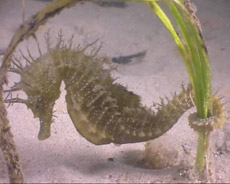 |
| A Spiny Seahorse in Studland
Bay clinging to a blade of eelgrass. |
The anchors
and chains of simple pleasure craft is one example of the serious
damage caused by our activities and exploitation of the world's
oceans. On an industrial scale, many marine habitats are destroyed
by fishing trawlers (bottom trawling) which indiscriminately scour
the seabead leaving behind hundreds of thousands of square nautical
miles of devastation. Now, the jewellery industry has dramatically
increased the scale of sea floor damage with the introduction
of giant diamond mining ships. Every twenty-four hours, such ships
suck up enough material from the sea floor to fill fifteen thousand
container lorries, whereby 400 tons of gravel are processed per
hour to extract the diamonds. The ship must accumulate twenty
thousand carats of diamonds every 4 weeks, and subsequently a
baked bean size can of diamonds represents over twenty thousand
tons of ocean floor, scooped up and processed. This new assault
on earth's resources by the jewellery extraction industry means
the destruction of thousands of square kilometers of complex sea
floor habitats. Ocean sediment is entirely displaced and homogenised,
an action which is known to alter and cause serious detrimental
effects to diverse marine ecosystems. Like the result of all dredging
and trawling processes, the sea bed is left baron and void of
life. And when or if life does return, the fragile ecology is
changed forever.
Although Atelier Laibach does not use newly mined diamonds or
precious metals, our comparably small contribution in helping
to protect marine habitats though our donations to the Seahorse
Trust is quite literally a drop in the ocean ... but for the sake
of the future of the shy and fragile seahorse, just as important.
Kerstin Laibach encourages customers to also donate
directly to the Seahorse Trust.
(See also our links
page for more details on projects we directly support)
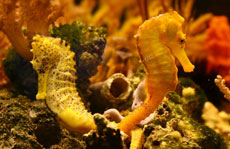 |
| Sea floor ecosystems are being
destroyed the world over by fishing and extraction industries. |
DORSET:
THE ARNE PENINSULAR AND BROWNSEA ISLAND
The Arne Peninsular is a beautiful landscape that overlooks Poole
Harbour. This threatened habitat is a mixture of heath, woodland
and marshland and home to a variety of wildlife, notably birds
in constant residence such as the Dartford Warbler and the Stonechat.
There are also many transitory birds such as the Nightjar and
the Avocet. The RSPB manage the area, to encourage breeding and
to conserve the area for future generations.
The biggest island in Poole Harbour is Brownsea, home to one of
the few UK habitats of the red squirrel. Brownsea is part owned
by the National Trust with a nature reserve leased to The Dorset
Wildlife Trust, where a host of migratory birds breed in the summer.
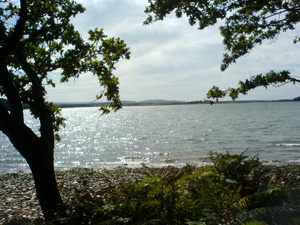
Across Poole Harbour towards Arne
from Brownsea Island
DORSET: CHESIL BEACH
Chesil Beach is an 18 mile
long tombolo (a bar of land with water each side) and the largest
in the UK. The most prominent features of Chesil are the "hills"
of shingle and the relentless sound of the surf crashing against
its steep shore. Areas of Chesil beach are closed to the public
during breeding seasons when the lichen, moss and salt marsh plants
near and amongst the shingle play host to nesting birds such as
Ringed Plovers, Reed Buntings, Oystercatchers and others.
On the mainland side of Chesil bank are the quite lagoons. The
Fleet Lagoon is one of North West Europe's most important marine
reserves and home to a variety of indigenous species of flora
and fauna (some becoming endangered) as well as transient species
such as migratory birds, including Pochard, Gadwell, Pintails,
common and little Terns.
The Fleet lagoon is also home to the famous Mute Swans of Abbotsbury.
DORSET: LYME BAY
The Jurassic and Triassic curve of Lyme Bay stretches between
South West Dorset and East Devon. Explore the hills or walk the
beaches near seaside towns and small hamlets such as Seatown,
Charmouth, Lyme Regis and Beer to experience some of the most
breathtaking vistas of seaside England.
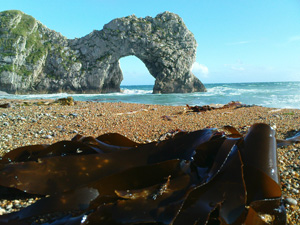
Durdle Door
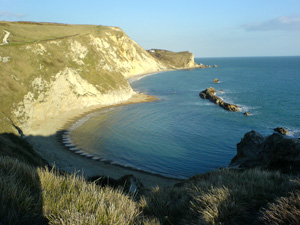
Overlooking Man-o-war Bay
DORSET: DURDLE DOOR
A familiar landmark for anyone who embraces the rugged beauty
of the Dorset Coast. A huge natural rock promontory of Purbeck
limestone and Portland Stone, of which one end arches out to sea.
The wildlife here is protected and Durdle Door is just along from
Kimmeridge Bay, home to the Dorset Wildlife Trust's Marine Centre.
Devon
and Cornwall
Further west and towards
the most southerly tip of England lay the counties of Devon and
Cornwall, where balmy coastlines and tranquil estuaries, warmed
by the Gulf Stream, harbour important sea life.
CORNWALL:
THE ROSELAND PENINSULAR
... is one of the most pastoral corners of mainland Britain and
a wildlife enthusiasts' hotspot for sighting dolphins, porpoises
and basking sharks along its coastline. Undersea can be found
a few remaining habitats of rare corals, while Inland and along
the estuarine eco-system of hidden creeks and mudflats you may
see Greenshanks, Peregrine Falcons, Black-tailed Godwits and Otters.
As well as working towards marine wildlife protection around the
Cornish coast, the Cornwall Wildlife Trust cares for 55 nature
reserves across the county.
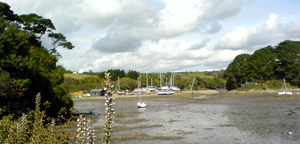
Low tide in an estuary of Roseland
*How
Laibach Helps
When you buy a Laibach piece, fifteen percent of the profit is
awarded to selected conservation / wildlife protection organisations
in areas of South or West England, often near where the main stone(s)
in your piece were gathered. If a piece does not include stones,
fifteen percent of profits is placed into a general fund and distributed
evenly to qualifying conservation and wildlife projects relative
to Laibach creations. Please see more about Laibach's wildlife
and environmental commitments here.
A NOTE ABOUT THE BRITISH
STONES IN LAIBACH PIECES:
The names given to Laibach pieces with British stones are sometimes
place names. Such names do not reflect the actual source from
where the stone in the piece was gathered. Where applicable, all
stones used are permissibly gathered or occasionally chosen from
an inherited 50 year old small collection of pebbles once gathered
from around southern areas of the UK.
Back
to South and West England Collection Menu
Laibach's
commitment to wildlife and the environment
Information
on the Laibach gathering area of the Southern Black Forest, Lake
Constance and the Three-Country Corner
Information
on Laibach donations to Gorongosa National Park, Africa
|